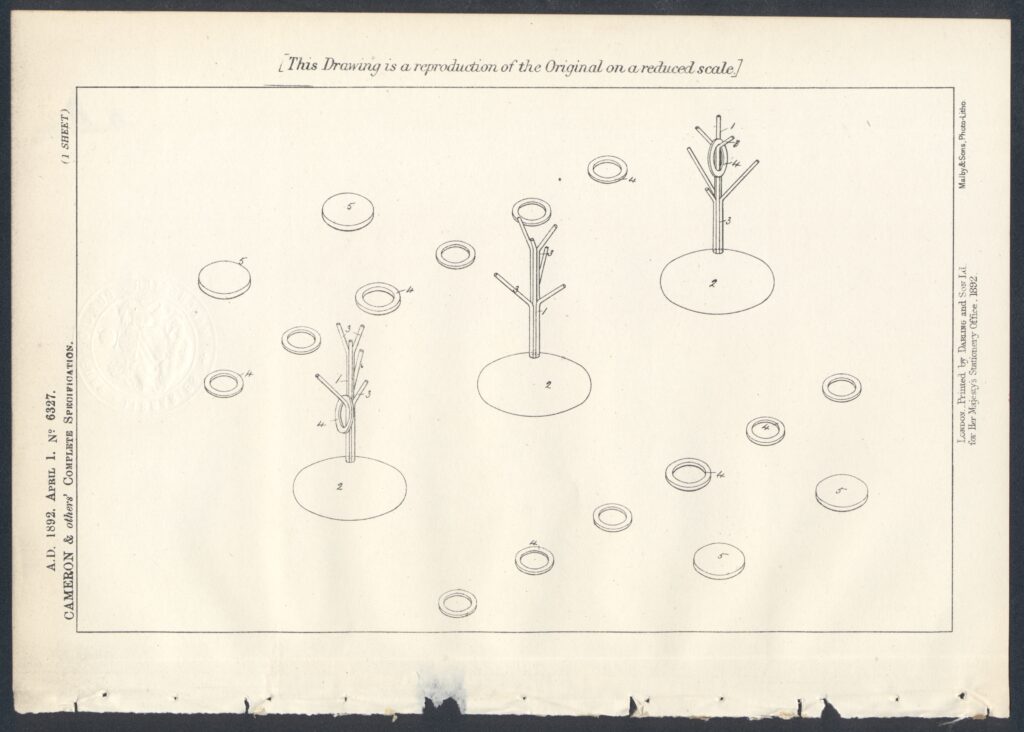Tiddlywinks Patents • How to Research
- Patent research ideas from the Association for Games & Puzzles International‘s online Game Catalog.
- Rick Tucker’s article on tiddlywinks patents in NATwA’s Newswink 11
- Tiddlywinks trademarks
- Tiddlywinks copyrights
- Tucker’s October 1996 article on collectible tiddlywinks games from the American Game Collector’s Association’s Game Researchers’ Notes
- European Patent Office’s Espacenet.com, with over 130 million patents from many countries around the world
- US Patent and Trademark Office
- Search for tiddlywinks patents at the PTO search site, and:
- enter “ccl/273/353” to find items in the tiddlywinks classification
- or “title/tiddl*” to find the name in the patent title
- or “abst/tiddl*” to find it in the patent abstract
- Google’s Patent Search with full-text search of all US patents
- Great Britain’s The Patent Office
- Canada’s Patent Database
Tiddlywinks Patents • United States
U.S. Patent Classification Schemes
U.S. Patents are categorized using a classification scheme. In 2013, the U.S. in conjunction with the European Patent Office adopted the Cooperative Patent Classification (CPC) system as the primary taxonomy for classifying patents. The CPC was based on the existing International Patent Classification (IPC) scheme and others. The IPC scheme is less granular than the CPC scheme. Many patents are identified with both CPC and IPC classifications.
In the CPC system, tiddlywinks games are generally classified under the following major class of utility patents, although they can also be found under other classes, such as sports simulations:
- CPC A63: Sports; Games; Amusements
- CPC A63F: Card, Board, or Roulette Games; Indoor Games Using Small Moving Bodies; Video Games; Games not otherwise provided for
- CPC A63F 9/02: Shooting or hurling games
- CPC A63F 2009/0295: (Tiddley winks type games)
- CPC A63F 9/02: Shooting or hurling games
- CPC A63F: Card, Board, or Roulette Games; Indoor Games Using Small Moving Bodies; Video Games; Games not otherwise provided for
To be precise: for “A63F 2009/0295”, the “A” is the CPC section, “63” is the class, “F” is the subclass, and “2009/0295” the group and subgroup. The full classification, “A63F 2009/0295” in this case, is called a CPC symbol.
Each patent is assigned one or more primary CPCs symbols and sometimes additional symbols for cross-reference purposes. The collection of all CPC symbols assigned to a patent is called a combination set.
In the prior U.S. Patent Classification (USPC) scheme, games were generally classified under the following major classes of utility patents:
- Class 273: Amusement Devices: Games (manual)
- Subclass 317
Aerial Projectile Game, Game Element (e.g., target, etc.) or Accessory Therefore Other Than Projector or Projectile, per se - Subclass 348
. Target - Subclass 353
.. Tiddlywink game
- Subclass 317
Before 19 February 1980, the following unofficial subclass was used under class 273 prior to the adoption of subclass 353:
- Subclass 95E
Aerial Projectile, “Tiddly-Wink”
The U.S. also issues design patents to protect the unique appearance of an item. Games generally fall within the following design patent class:
Games may also be found in other classes and subclasses, or cross-indexed with multiple classifications.
Note that each U.S. patent number is assigned on the date the patent was granted/published. Unlike early U.K. patents, U.S. patent numbers have always been consecutive from one year to the next, and hence, are unique.
Brief summaries of patent claims are printed in the Official Gazette (OG) of the U.S. Patent and Trademark Office.
U.S. Patent Resources Online
- U.S. Patent and Trademark Office Presentation on Patents and Patent Searching at 2022 AGPI convention by patent examiners David Duffy and Julie Brocketti on 13 May.
- Google Patent Search. Search the text of all US patents since 1790, and retrieve matching patent images.
- U.S. patents. All U.S. patents are online at the U.S. Patent and Trademark Office. However, only images are available for most patents from 1790 to 1975. Patent images are provided in .PDF format. Searching of the patent text is available for patents since 1975. Searches before 1975 can only be performed on Issue Date, Patent Number, and Current Classification.
- Free Patents Online includes PDFs of all U.S. patents, and recent European patents.
U.K. Patent Resources Online
- Early patents at the British Library
- Registered designs at The National Archives at Kew
- Great Britain’s The Patent Office
Worldwide Patent Resources Online
- The European Patent Office‘s Espacenet contains patents for over 130 million patents worldwide (including the United States, United Kingdom, and Canada), including complete coverage for some countries. Text in all patents can be searched (though many early ones only have text produced through optical character recognition which isn’t always accurate). In addition, the text in patents can be translated to a variety of languages. Cross-references are provided for the same or quite similar patent granted in multiple countries.
Tiddlywinks Patents • United Kingdom
Note that early UK patent numbers started anew each year, and the numbers are associated with the year of first application, not the year the patent was granted, and not necessarily the year a complete specification was submitted following submission of a provisional specification. Filing dates are usually those of the provisional specifications. A game marked “Protected” is one for which a provisional specification was submitted but not yet granted. A game marked “By Letters Patent” is one for which a patent was granted.
GB 1888/16215 A • granted 10 October 1889
title • A New and Improved Game
by • Joseph Assheton Fincher of 114 Oxford Street, London (8 November 1888) and 9 Berners Street, London (7 August 1889)
patent country • United Kingdom
patent ID • GB188816215A
provisional specification • 8 November 1888
complete specification • 7 August 1889
granted • 10 October 1889
associated game • published by John Jaques & Son as TIDDLEDY WINKS; some games have a label, either on the box bottom or under the box lid with: “J A Fincher Inventor”.
commentary • While this was the first submitted GB patent for a tiddlywinks-style game, it wasn’t the first patent granted for a tiddlywinks-style game; the first such granted patent was GB188818789A by Wilson and Margary for a game of tennis played tiddlywinks-style, around 7 months before when this patent by Fincher was granted. Also note that the date that the provisional specification for this Fincher patent was submitted for Fincher’s patent predates all dates submitted for the patent by Wilson and Margary.
associated trademark • TIDDLEDY-WINKS
archives • original printed patent (Rick Tucker Tiddlywinks Collection)
A new and improved game played with counters or flippers made of wood, ivory, bonn, or other substance, and a bowl or vessel of any shape, made of wood, china, glass, ivory or other substance, the object of the said counters or flippers being to press the edge of a smaller set of counters provided for the purpose and so cause them to jump into the bowl or vessel placed in the centre of the table [...]; by drawing the flipper B sharply backwards and at the same time pressing downwards, the small counter C is made to jump into the bowl D.
excerpt from patent • GB188816215Ax`
GB 1888/18789 A • granted 16 March 1889
title • A Modification of Lawn Tennis Forming an Indoor Game
by • Harold Charles Wilson of Stradsett Hall, Downham Market, Norfolk, England UK and Alice Constance Inverarity Margary of The Hollies, Frant Road, Tunbridge Wells, England UK
patent country • United Kingdom
patent ID • GB188818789A
complete specification • 12 December 1888
granted • 16 March 1889
commentary • while this was the second submitted GB patent for a tiddlywinks-style game, this was the first tiddlywinks-style patent granted, 7 months after GB188816215A, Fincher’s patent, was granted. Also note that the date of the provisional specification submitted for Fincher’s patent predates all dates for this patent by Wilson and Margary.
associated game • tennis tiddlywinks published by John Jaques & Son as FLITTERKINS; some examples have a sticker on the box bottom: “H. C. Wilson Inventor”; it is not understood why Alice Margary isn’t also noted as a co-inventor of this game on the sticker. As is the norm for patents, the patent description does not mention the name of the game (Flitterkins in this case).
trademark • John Jaques applied for the trademark FLITTERKINS on 31 July 1889, application # 91,920, and its registration was approved during the week of 6–13 March 1890, the same time Fincher’s TIDDLEDY-WINKS trademark was registered.
note • no drawings are included in this patent
archives • digitized printed patent (Rick Tucker Tiddlywinks Collection)
The game is started by one player serving the counter-ball which is done by placing the ball or counter on the service line of his own court and pressing it with his counter racquet so as to cause it to jump over the net and fall into the right court as in lawn tennis [...]
excerpt from patent • GB188818789A
GB 1889/09387 A • granted 22 March 1890
title • New or Improved Game and Game Apparatus, Applicable for Use on Parlour Tables
by • George Scott of 7 Mount Pleasant, Oxton, Birkenhead, County of Chester, England
patent country • United Kingdom
patent ID • GB188909387A
application ID • 9387/89
provisional specification • 6 June 1889
complete specification • 6 March 1890
granted • 22 March 1890
associated games • tiddlywinks golf, published as Golfette and Golfiards
note • also registered as U.S. patent US431170A
archives • digitized printed patent (Rick Tucker Tiddlywinks Collection)
GB 1889/09882 A • granted 22 March 1890
title • A Game of Skill
by • Edward Fuller Maitland of Garth House, Breckonshire, Republic of South Africa
patent country • United Kingdom
patent ID • GB188909882A
application ID • 9882/89
provisional specification • 17 June 1889
complete specification • 10 December 1889
granted • 25 January 1890
grant revoked • “Opposition to the Sealing having been successful, a Patent has not been granted for this Invention.”
archives • original printed patent (Rick Tucker Tiddlywinks Collection)
This Invention relates to a game of skill played with "counters" by two or more persons on a table or other flat horizontal surface. Obstacles, such as rings, hoops, steps, inclined planes—either direct or sinuous in direction—as also representative obstacles such as bridges, hurdles, ditches and so forth, placed in a circle on the table. These obstacles, which I make by preference of wood, covered or uncovered may be of one shape or varied in shape. There is a starting point and a winning point. The players play in turn, the object being to cause "counters" by pressure on the edge, to pass over, under, or through the obstacles and arrive first at the winning post.
excerpt from patent • GB188909882A
GB 1890/05650 A • granted 17 May 1890
title • Courts
by • Mascie Taylor
patent country • United Kingdom
patent ID • GB189005650A
complete specification • 15 April 1890
granted • 17 May 1890

GB 1890/13768 A • granted 30 May 1891
title • Improvements in Games Played with Counters or Discs
by • John Francis Peasgood of 4 Maberley Road, Upper Norwood, county of Surrey, England, UK
patent country • United Kingdom
patent ID • GB189013678A
complete specification • 14 April 1891
provisional specification • 2 September 1890
granted • 30 May 1891
archives • original printed patent (Rick Tucker Tiddlywinks Collection)
This invention for improvements in games played with counters or discs has for its object to provide a new game, somewhat similar in principle to bagatelle, in which the cost of the apparatus necessary for the playing of the game shall be very small indeed compared to that of a bagatelle table, balls and cues and consists essentially in a flat board on which are marked circles corresponding to the pockets of a bagatelle board and numbered in a similar manner, of a felt or other suitable disc, and of a number of counters or discs and a blade of ivory bone or the like. In okaying the game the felt disc is arranged at a suitable distance from the board and a counter or disc is placed thereon and projected towards the board by pressing on its edge with the blade the object being, to project the counter or disc into one or other of the circles or pockets.
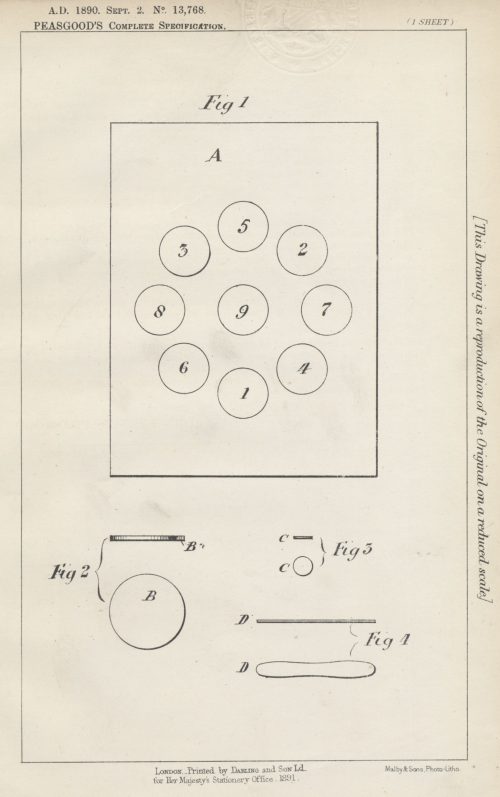
GB 1892/05482 A • granted 23 April 1892
title • An Improved Game
by • Ignaz Sulzbacher, of Nuremberg, Empire of Germany
patent country • United Kingdom
patent ID • GB189205482A
complete specification • 18 March 1892
granted • 23 April 1892
associated game • Sweet Wedding Bells issued under the brand of the Globe Series of Games, which was produced by Ignaz Sulzbacher and his partner, Emil Oppenheimer. Years later, this game was published by Spear’s Games as Sweet Wedding Bells – A Novel Game of Tidley Winks in 1930 and thereabouts.
archives • original printed patent (Rick Tucker Tiddlywinks collection)
In carrying out my invention I employ a box having a series of openings around It, which box is advantageously in the form of a tower or other building, the windows of which form the openings referred to. Inside the tower I place a bell.
The game is to cause counters or the like to fly through the openings or windows and to strike the bell, the impulse being preferably imparted to such counters by nipping them with another counter or other instrument held in the hand. My invention will be readily understood by reference to the accompanying drawing which represents my box in the form of a church tower, the box being shewn in such a position that the counters flying through the window-openings will strike the bell.excerpt from patent • GB189205482A
GB 1892/06327 A • granted 7 May 1892
title • An Improved Game Apparatus
by • William Cameron, Alexander Cameron, and Allan Cowland Cameron (the Cameron Brothers) of 12, Cranbourne Street, Leicester Square, county of London England, UK
patent country • United Kingdom
patent ID • GB189206327A
complete specification • 1 April 1892
granted • 7 May 1892
game • tree-shaped targets
archives • original printed patent (purchased to arrive in Rick Tucker Tiddlywinks Collection)
This invention relates to an improved game-apparatus which comprises the several constituents of, a branched structure or structures designed to catch and retain annular or other perforated discs or like devices while spinning around in aerial flight, if properly directed :—a series of such annular or other perforated discs or like devices adapted, while so in flight, to catch on and be retained by one or more of the branches of such structure or structures;—and disc or counter-like or equivalent devices adapted to depress one edge of said perforated discs or the like, when lying flatwise on a yielding surface, and to cause the same, when slipping or escaping therefrom, to vault or fly and spin around while in flight, and to alight, on one or more of the branches of said structure or structures should the player exercise sufficient skill in depressing said perforated disc to properly direct its flight.
excerpt from patent •

GB 1892/22663 A • granted 12 May 1894
title • (to be provided)
by • James Henry Hannay
patent country • United Kingdom
patent ID • GB18932266A
complete specification • 25 November 1893
granted • 12 May 1894
game • golf tiddlywinks
GB 1894/05866 A • granted 15 September 1894
title • A New Parlour Game
by • Harry Owen Roberts of 4 Commercial Road, Gloucester, England UK
patent country • United Kingdom
patent ID • GB189405866A
provisional specification • 20 March 1894
complete specification • 9 August 1894
granted • 15 September 1894
game • Salomo, published by T. Ordish & Co., 99 Fore Street, London, E. C.
GB 1894/06943 A • granted 12 May 1894
title • Improvements in Parlour Games of Skill, applicable also as Aids to and Tests of Education
by • Walter Kershaw of Kershaw’s Bazaar, Blackpool, in the County of Lancaster, England, a Fancy Goods Dealer; John Bentley Brierly of 103 Camp
Street, Broughton, Manchester, in the County of Lancaster, England, a Traveller.
patent country • United Kingdom
patent ID • GB189406943A
complete specification • 7 April 1894
granted • 12 May 1894
game • spelling targets
GB 1894/18061 A • granted 19 September 1895
title • Mechanical Toy Head to be Used for a Game in which Counters, Coins, or other Articles are Projected into the Mouth
by • William Ditchburn of 97 Park Road, Newcastle-on-Tyne, England UK
patent country • United Kingdom
patent ID • GB189418061A
complete specification • 22 September 1894
granted • 19 January 1895
excerpt • relates to a game resembling tiddledy winks, in which counters, coins, and the like are projected or thrown by players into the open mouth of a mechanical head
GB 1896/01724 A • granted 29 February 1896
title • A New or Improved Game
by • William Henry Nicholls of Park Street, Abergavenny, County of Monmouth, a dentist, and Gordon Fitzherbert Nicholls of 47 Summer Hill, Birmingham, County of Warwick, a surgeon
patent country • United Kingdom
patent ID • GB189101724A
complete specification • 24 January 1896
granted • 29 February 1896
game • a miniature golf tiddlywinks game
GB 1897/25035 A • granted 15 October 1898
title • A New or Improved Game, and Appliances for Us[e] in Playing same.
by • Charles Edward Forbes Mouat-Biggs, of 2 Fauconberg Villas, Bayshill, Cheltenham, County of Gloucester, England
patent country • United Kingdom
patent ID • GB189725035A
provisional specification • 28 October 1897
complete specification • 28 July 1898
granted • 15 October 1898
excerpt •
The game, which can be played by two, four or other number of players, is played upon a specially arranged board or pad with variously coloured counters, which have to be flipped or shot in a particular order and under certain conditions into a receptacle arranged centrally on the board, the game being won by the player who first deposits in the required order and manner all his counters in the receptacle. […]
On the surface of the cloth, which is called “Klondyke,” are marked out eight red base lines or “allotments,” all of which allotments are placed equidistant from the centre of the board; the centre is marked by a circular gold patch called the “deposit” on which is placed the “nugget bucket” consisting of a small gilded wooden bucket. With the “deposit” as the central point, a gold circle, called the “vein,” a foot in diameter is painted round it, and on this circle is placed a gilded wooden or cardboard ring, 2½ inches high, called the “gold quartz reef.”
GB 1899/10760 A • granted 9 September 1899
title • A Game.
by • John Alfred Rivington, of Glenhurst, Mansfield Road, Reading, in the County of Berkshire, England, a clerk of holy orders
patent country • United Kingdom
patent ID • GB189910760A
provisional specification • 23 May 1899
complete specification • 31 July 1899
granted • 9 September 1899
excerpt •
The game according to this invention is played upon a board divided into squares, upon which are moved a series of pieces which represent ships in the case of the game imitating a naval battle, but where a land battle is simulated the pieces represent, either individuals, companies of men, regiments, guns or the like.
The game consists in controlling, checking or counter-acting the moves of the opposing player by the projection of counters or the like into or on to the pieces, which are preferably formed as cups or trays so as to retain the counters lodged in them.
GB 1900/00326 A • granted 22 December 1900
title • A Game.
by • William Evans, of 21 Pine Road, Cricklewood, in the County of Middlesex, England, a commission agent
patent country • United Kingdom
patent ID • GB190000326A
provisional specification • 5 January 1900
complete specification • 5 October 1900
granted • 22 December 1900
excerpt •
This invention for improvements in games played on a board relates to that class of game in which a disc is “chipped” or projected along a flat board by means of a projector, or stiff flat strip by drawing the projector gently over the edge of the disc.
Now according to this invention a board is provided with a central hole or pool and with a number of india rubber or elastic cannon posts and with obstructions and with small holes. The upper face of the disc is more or less spherical so that it can be slid over the surface instead of leaping over it.
The object of each player is to project his discs into the central pool. The india rubber posts form obstructions but also enable the player to avoid obstiuctions by cushioning or cannoning off a post into the pool. When a player projects a disc into a small hole he must start with that disc from home.
GB 1906/00513 A • granted 31 May 1906
title • Improvements in or relating to “Table” Football.
by • Zdenko Krulis, of Königl, Weinberge near Prague, Divisova 29, Empire of Austria, an engineer
patent country • United Kingdom
patent ID • GB190600513A
complete specification • 8 January 1906
granted • 31 May 1906
excerpt •
The football players proper are represented by small discs s (Figure 3).
They are made of bone, horn, celluloid or some other elastic material and have a suitable diameter, say 15 to 30 millimetres, according to the size of the playing field. Each of these discs has a smooth flat bottom surface 1, whereas the upper surface 2 is rounded or has the shape of a section of a ball, while the lateral surface 3 is conical. The edge 4 between the upper and lateral aurfaces is rounded off. The playing discs s1 which are to represent the goalkeepers are slightly larger and heavier than the remaining discs s so that they may better resist the shock of the ball.
The ball is also represented by a disc v (Figure 4) but its diameter is smaller than that of the playing discs s, its bottom surface 5 and the upper surface 6 are flat, and the lateral surface 7 vertical. The playing discs are operated or propelled by means of a narrow disc k (Figure 5) say of 4 to 5 centimetres in diameter which is held between the index fingers and thumbs of both hands, placed on the conical lateral wall 3 of a playing disc s, for instance, as shown in Figure 6 and depressed. According to the extent of the pressure, the playing disc is caused to slide over the playing surface to a greater or lesser extent in a direction normal to the surface of the disc k.
GB 1906/25270 A • granted 9 May 1907
title • A Game and Apparatus for use in Playing the same.
by • William Clinch Poole, of 62 Belleville Road, Wandsworth Common, in the County of Surrey, an architect and surveyor
patent country • United Kingdom
patent ID • GB190625270A
provisional specification • 6 November 1906
complete specification • 6 February 1907
granted • 9 May 1907
excerpt •
The game is played by causing discs, or the like, which I call jumpers, and which on being manipulated by a suitable appliance, which I call a flipper, to spring or fly into compartments or spaces, of different values, provided on a suitable diagram or figure marked-off on a board, the player winning whose score, after a predetermined number of turns or innings, totals the highest.
Fincher's non-Tiddlywinks Patents • United Kingdom
(to be provided)
Tiddlywinks Patents • United States
title • Board Games with Projectiles and Methods of Playing Same
by • Kimberley Matilla, Andrea Ehret
Int’l class • A63F3/00075
US class • 273/317
filed • 31 May 2006
granted • 20 September 2007
assignee • Mattel, Inc.
excerpt •
- Page 2: For example, a device similar to the winks used in the game Tiddlywinks may be used as a projectile. In such embodiments, the player may hold one element of the projectile and exert force with that element onto another element of the projectile, causing the latter to fly through the air.
Tiddlywinks Citations in Other Patents • United States
The games described in these patents are not true tiddlywinks-style games.
title • Methods, tiles and boards for playing games that schematize competitive yet non-combative ecological processes, including multi-generation games of strategy and territory occupation played with progressively sized tiles on geometric grids
by • David Michael Geshwind of New York, New York USA
int’l class • A63F3/00
US class • 273/236
filed • 27 January 2003
granted • 27 January 2005
excerpts •
- Page 7: If one color, pieces can comprise inexpensive reversible tokens like wooden checkers or plastic tiddlywinks;
- Page 15: These may consist of tiddlywinks, checkers, coins (pennies and dimes), ‘go’ stones, or any other available tokens.
US 2008/0141282 A1
title • Control of Interactions within Virtual Environments
by • Gershon Elber, Orit Shaked, Oded Shmueli
US class • 719/318
filed • 12 February 2008
granted • 12 June 2008
excerpts •
- Page 6: Thus for example, a counter restricted to two dimensional space may be used for Snakes-and-Ladders or Ludo, or alternatively be assigned three dimensional mobility, and allowed to move in 3 dimensions and then used for tiddlywinks.
US 2010/0208942 A1
title • Image Processing Device and Method
by • Robert Mark Stefan Porter and Clive Henry Gillard
US class • 382/106
filed • 8 December 2009
granted • 19 August 2010
excerpt •
- Page 11: [0129] However, over distances of tens of meters, which are typically involved when filing sports on sports pitches, such 3D camera systems may lack the depth resolution needed to be able to generate an offset amount for each pixel corresponding to a detected object within a captured image so as to present an effective three-dimensional appearance to a user. Therefore, the embodiments described above in which the offset amount is generated in dependence upon distance data in the depth map data are more applicable to situations in which relevant objects within a scene are within a few metres of the camera. In the context of sports footage, such sports may be boxing, snooker, table tennis, tiddlywinks, gymnastics, fencing and the like, although it will be appreciated that, subject to sufficient depth resolution, other events or scenes could also be captured.
Tiddlywinks Design Patents • United States
Tiddlywinks Citations in Other Design Patents • United States
The design patents listed in this section include those for games similar to tiddlywinks, e.g. catapult games using discs, and those that are not for games
but use the term “tiddlywinks” to describe an effect or action.
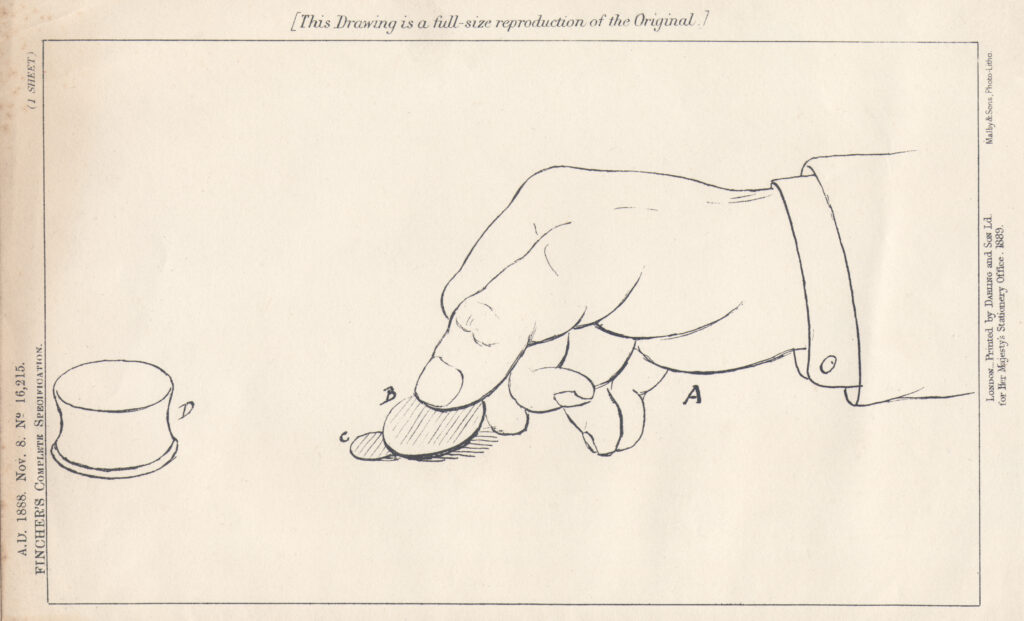
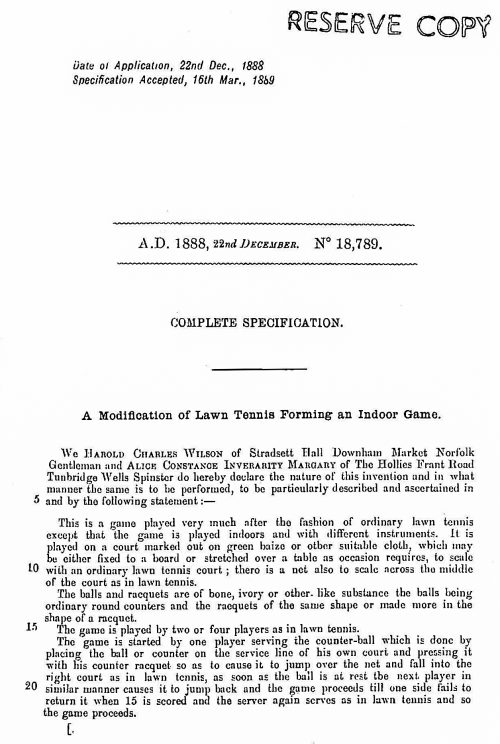
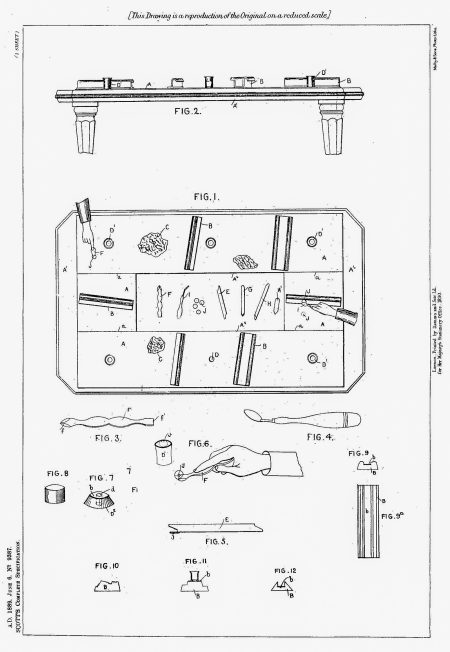
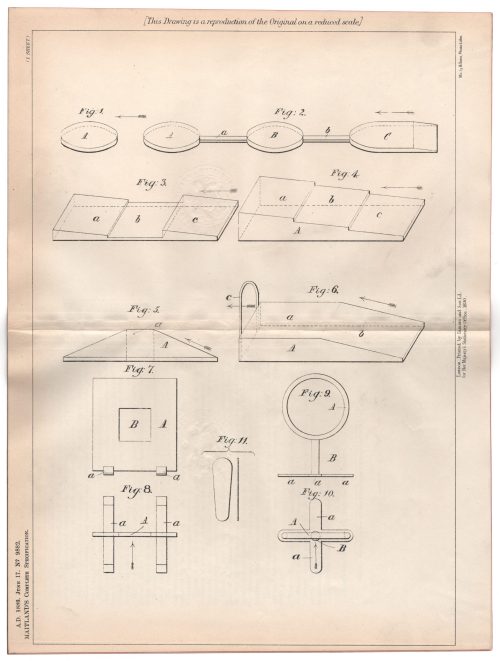
![UK patent: An Improved Game, by Ignaz Sulzbacher of the firm Oppenheimer & Sulzbacher, of Nuremberg, Germany. Tiddledy winks bell tower. [+template:(Tucker Tw ID • [+xmp:title+] — publisher • [+iptc:source+] — title • [+xmp:headline])+]](https://tiddlywinks.org/wp-content/uploads/elementor/thumbs/UK_Patent_5482_year-1892_p2-1-scaled-prpoai01y4y73srf2po3ug7dvxu6sdn341n15352qq.jpg)
